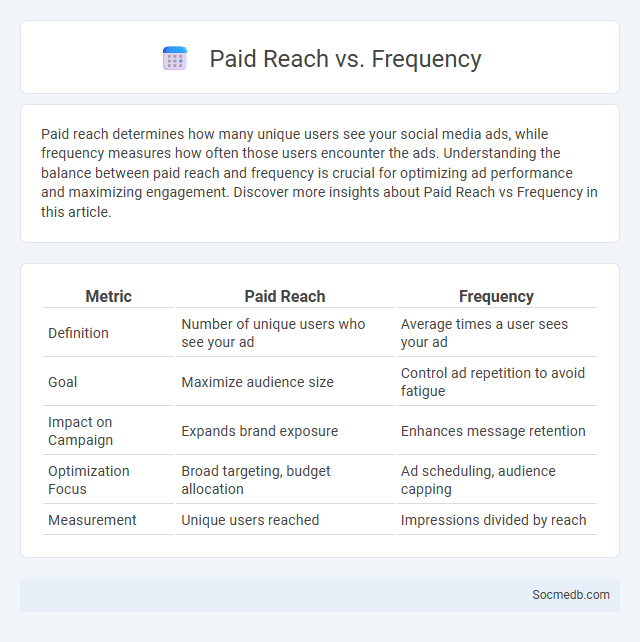
Photo illustration: Paid Reach vs Frequency
Paid reach determines how many unique users see your social media ads, while frequency measures how often those users encounter the ads. Understanding the balance between paid reach and frequency is crucial for optimizing ad performance and maximizing engagement. Discover more insights about Paid Reach vs Frequency in this article.
Table of Comparison
| Metric | Paid Reach | Frequency |
|---|---|---|
| Definition | Number of unique users who see your ad | Average times a user sees your ad |
| Goal | Maximize audience size | Control ad repetition to avoid fatigue |
| Impact on Campaign | Expands brand exposure | Enhances message retention |
| Optimization Focus | Broad targeting, budget allocation | Ad scheduling, audience capping |
| Measurement | Unique users reached | Impressions divided by reach |
Understanding Paid Reach in Digital Marketing
Paid reach in digital marketing refers to the number of unique users who see content as a result of paid advertisements on social media platforms like Facebook, Instagram, and Twitter. It is a crucial metric for measuring the effectiveness of ad campaigns, providing insights into audience engagement and brand visibility beyond organic reach. Optimizing paid reach involves targeting specific demographics, utilizing audience segmentation, and analyzing performance metrics to maximize return on ad spend (ROAS).
Defining Frequency in Advertising Campaigns
Frequency in social media advertising campaigns refers to the number of times your target audience sees a specific ad within a set period. Optimizing this frequency balances ad exposure to maximize engagement without causing ad fatigue or annoyance. Tracking frequency metrics helps ensure your campaigns deliver effective brand recall while maintaining positive user experience.
Key Differences Between Paid Reach and Frequency
Paid reach quantifies the number of unique users exposed to a social media ad, defining the breadth of the audience. Frequency measures how often the same users see the ad, indicating the intensity of exposure. Balancing paid reach and frequency is essential for optimizing ad effectiveness and budget allocation in social media campaigns.
How Paid Reach Impacts Campaign Performance
Paid reach significantly enhances your social media campaign performance by increasing content visibility beyond organic followers, driving higher engagement and conversion rates. Targeted paid ads allow precise audience segmentation, ensuring your message reaches users most likely to interact and convert. By investing in paid reach, you amplify brand awareness and accelerate campaign results with measurable ROI.
The Role of Frequency in Brand Recall
Consistent posting frequency on social media significantly enhances brand recall by keeping Your brand top-of-mind for the audience. Studies show that brands engaging users multiple times per week experience higher recognition and improved consumer retention rates. Maintaining an optimal balance in post frequency ensures sustained exposure without overwhelming followers, maximizing brand visibility and engagement.
Balancing Paid Reach and Frequency for Optimal Results
Balancing paid reach and frequency on social media is essential to maximize ad effectiveness without overwhelming your audience. Optimizing frequency ensures your message reaches the right people often enough to drive engagement, while avoiding ad fatigue that decreases performance. You can achieve optimal results by carefully monitoring campaign metrics and adjusting your budget allocation between expanding reach and increasing frequency based on audience behavior.
Common Misconceptions: Paid Reach vs Frequency
Many people mistakenly believe that increasing paid reach guarantees higher frequency of ad exposure, but these metrics function independently in social media marketing. Paid reach measures the unique number of users who see your ad, while frequency tracks how often each user views it, impacting ad recall and conversion rates differently. Understanding this distinction helps you optimize budget allocation and campaign effectiveness.
Strategies to Maximize Paid Reach and Frequency
To maximize paid reach and frequency on social media, target your audience with precise demographic and interest-based segmentation, ensuring your ads appear to the most relevant users. Use A/B testing to optimize ad creatives and placements, increasing engagement and reducing ad fatigue while maintaining a balanced frequency cap to avoid oversaturation. Your campaign's performance can significantly improve by leveraging lookalike audiences and retargeting strategies that reinforce brand recall and drive conversions.
Measuring Success: KPIs for Paid Reach and Frequency
To measure success in social media paid campaigns, key performance indicators (KPIs) such as paid reach and frequency are essential. Paid reach quantifies the number of unique users exposed to Your ad, providing insights into audience penetration and campaign scale. Frequency tracks how often those users see the ad, helping balance exposure to avoid ad fatigue while maximizing engagement.
Choosing the Right Approach: Paid Reach or Frequency
Selecting the right approach between paid reach and frequency depends on campaign objectives and audience behavior. Paid reach maximizes the number of unique users exposed to the content, making it ideal for brand awareness and expanding market presence. Frequency focuses on repeated exposure to reinforce messaging and drive conversions, especially effective for retargeting and nurturing engaged audiences.
 socmedb.com
socmedb.com